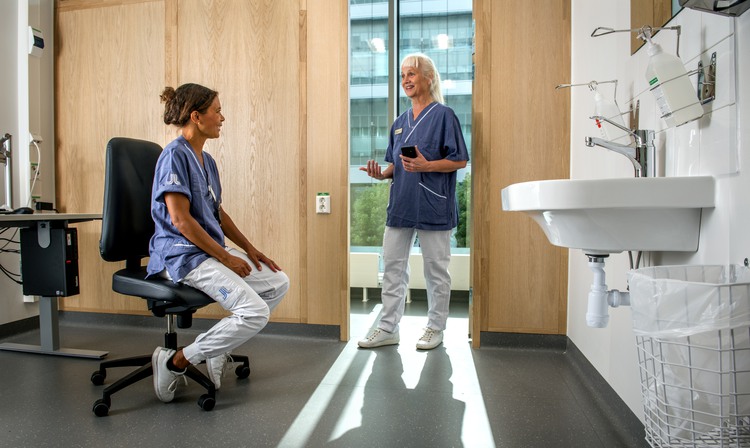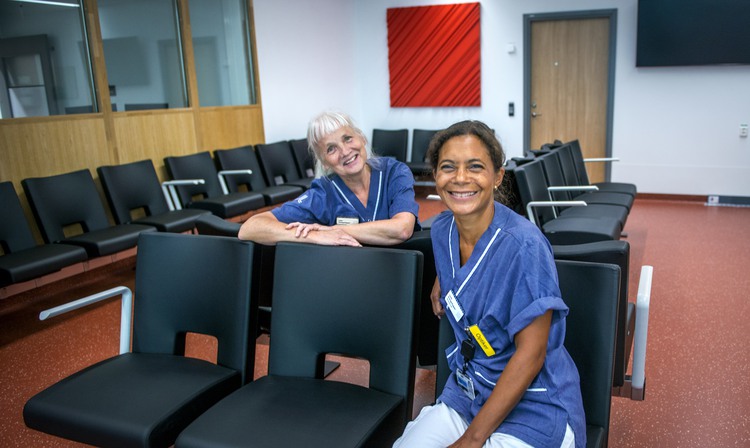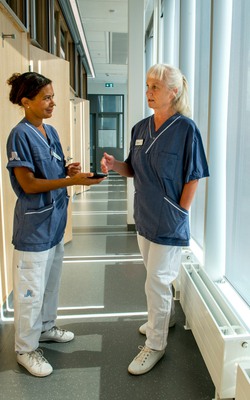Every day, St. Erik’s accident and emergency service has a large number of people seeking treatment. Far from everyone actually needs to come to the eye emergency service, but some have injuries or problems that have to be treated immidiately. Therefore, it is important to have a system that quickly triages patients in order to provide the right treatment at the right time.
Some people that come to our emergency service are advised on self-care that they can perform at home, while others may have debris under the eyelid that can be quickly remedied by one of our opticians or eye nurses. In this way, the waiting time will not be unnecessarily long for those with serious urgent problems, that must be quickly examined by an eye specialist, says Linda Kwenga Koppari, assistant chief optician at St. Erik Eye Hospital’s accident and emergency service.
Doctor Eva Zand is medically responsible for both the emergency service and the resident doctors. She has worked at the service for 20 years, longer than anyone else.
I think it's amazing and I like not really knowing what tomorrow will bring. The emergency room is a place where we as staff must always be ready for change. We have to be able to treat many patients per day, she says.

Linda Kwenga Koppari and Eva Zand tell us that the large distances between examination rooms have been a concern, but that in the new premises, the rooms are located closer together.
Photo: Jens Sølvberg
Non-emergency patients who need to be examined by an ophthalmologist in the near future, are referred to one of the private eye clinics working on behalf of Region Stockholm. Another option for these patients is to come to St. Erik’s educational clinic, which is next door to the eye emergency service.
The educational clinic is a unique collaboration with Karolinska Institutet’s programme for opticians. There, patients who do not have acute problems, but still need to see an ophthalmologist, can get an appointment within two days. They get to meet opticians under supervision, resident doctors, and an eye specialist, says Linda Kwenga Koppari.
St. Erik’s accident and emergency service is staffed by specialised opticians, eye nurses, nurses, assistant nurses, ophthalmologists and resident doctors who are completing their specialist training at St. Erik.

St. Erik Eye Hospital’s new premises are purpose-built for modern eye care. Eva Zand and Linda Kwenga Koppari show the new waiting room of the eye emergency service.
Photo: Jens Sølvberg
In the emergency room, we are presented with many common ailments and several of these, the resident doctors can treat without supervision, but sometimes more unusual cases come up. I am always available if the resident doctors need to ask me anything, and if necessary, we can consult the specialists in the other sections of the hospital, says Eva Zand.
The significant distances between the examination rooms were a concern in St. Erik’s previous premises. In the new premises, these rooms are located closer together.

Many of the patients can be treated by resident doctors without supervision, but sometimes more unusual cases appear. Linda Kwenga Koppari and Eva Zand talk in the back corridor.
Photo: Jens Sølvberg
One feature is the rear corridor. Each reception room has doors in two directions. One door, where the patient enters, leads to the waiting room and the other leading to the rear corridor is for the staff only.
I really like the floor plan. The fact that the examination rooms are available from two sides facilitates my supervision of the resident doctors, says Eva Zand.
Security has also been improved in the new premises. The rear corridor provides staff with a retreat route in cases where they are subjects to threats or violence from a patient or relative. The floor plan is also better from a confidentiality perspective, according to Linda Kwenga Koppari.
In the past, we have discussed patient cases in places where there were other patients around. Although we never mention any names, it is much more private to have these conversations in a separate corridor, she concludes.
Text: Maja Lundbäck